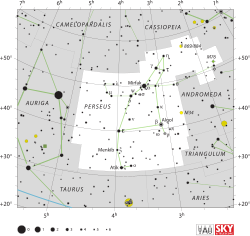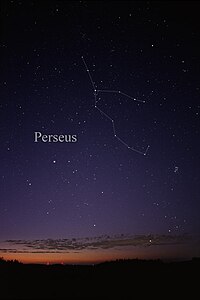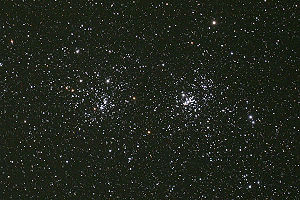英仙座
| 星座 | |
 | |
| 縮寫 | Per |
|---|---|
| 所有格 | Persei |
| 象徵物 | 珀耳修斯 |
| 赤經 | 3h |
| 赤緯 | +45° |
| 家族 | 英仙家族 |
| 象限 | NQ1 |
| 面積 | 615平方度 (第24位) |
| 主要恆星 | 19 |
| 拜耳/佛氏 恆星 | 65 |
| 有行星的恆星 | 7 |
| 亮度3m以上的恆星 | 5 |
| 距離在10秒差距(32.62光年)內的恆星 | 0 |
| 最亮星 | 天船三 (1.79m) |
| 最近的恆星 | G 174-14 (33.62 ly, 10.31 pc) |
| 梅西爾天體 | 2 |
| 流星雨 | 英仙座流星雨 英仙座ε九月流星雨 |
| 鄰接星座 | 白羊座 金牛座 御夫座 鹿豹座 仙后座 仙女座 三角座 |
| 可以看見的緯度範圍: +90°至−35°之間 最適合觀賞的月份:12月 | |
英仙座是北天星座,以希腊神话英雄珀耳修斯命名,是二世纪天文学家克劳狄乌斯·托勒密所列48个星座[1],也属國際天文聯會定义的88个现代星座[2]。英仙座附近有许多同样以希腊神话命名的星座,如西侧的仙女座、北面的仙后座。星座南面挨着白羊座和金牛座,东靠御夫座,北临鹿豹座,西接三角座。19世纪早期星图还把英仙座画成持有美杜莎头部的珀耳修斯[3],两个星群一起得名“珀耳修斯与美杜莎的头”[4]。
银河系的銀河平面穿过英仙座,星座以1.79视星等的黄白超巨星天船三最亮。天船三与周围许多恒星都属英仙座α疏散星团,其中又以肉眼可见的食双星大陵五最富盛名,身为變星,大陵五还与代表凶险的传说联系在一起。英仙座的知名星体众多,英仙座X是拥有中子星的联星,英仙座GK是视星等在1901年达到颠峰的新星,达0.2。中国古代就在英仙座发现两个距离很近的疏散星团组成雙星團。英仙座星系團距地球2.5亿光年,是规模非常庞大的星系团,因英仙座得名。一年一度的英仙座流星雨是非常显著的流星雨,輻射點就在英仙座星系团。
历史与神话
[编辑]
根据希腊神话所述,珀耳修斯是达那厄之子,受波吕德克特斯国王之命去取戈耳工美杜莎的头颅。美杜莎能把注视她双眼的人变成石头,珀耳修斯趁她熟睡时将她斩首,美杜莎的尸体生出珀伽索斯和克萊薩爾。[6]珀耳修斯继续赶赴克普斯的王国,挽救向刻托献祭的国王之女安德洛墨達。他用剑杀死刻托救下安德洛墨達,[7]用美杜莎的头把波吕得克忒斯国王及其追随者变成石头,把渔夫狄克提斯推上国王之位[6]。珀耳修斯与安德洛墨達结婚并育有六个孩子[7]。英仙座代表珀耳修斯,旁边是代表安德洛墨達的仙女座,代表克普斯的仙王座,代表安德洛墨達之母卡西歐佩亞的仙后座,代表刻托的鲸鱼座和代表珀伽索斯的飞马座[6]。
公元前911至605年新亚述帝国统治巴比伦期间,英仙座人称“老人座”,此后星座又在七世纪的天文学《星表》中与东方联系起来[8]。
非西方文明天文学
[编辑]中国古代天文学将西方文明划入英仙座的恒星分为四个星官。“天船”属西方七宿“白虎”的第三宿胃宿[9],代表华人为应对重大洪灾季节建造的大船。以天船命名的恒星位于英仙座北部,如天船七、天船五、天船四、天船三、天船二和天船一。[10]:346“积水”同属胃宿,代表八月底至九月初洪水季节开始时可能出现的特大洪灾,星官包含的英仙座恒星只有积水,天船七可能也在其中[10]:349。“大陵”也是胃宿星官,代表八月埋葬大规模处决罪犯的堑壕,在英仙座拥有大陵四、大陵增十八、大陵六、英仙座24、大陵增十六和英仙座17。“积尸”代表处决犯人的尸体,在英仙座只有一颗同名恒星。[10]:349
波利尼西亚文明大多不把英仙座单独视为星座,只有社會群島居民为星座起名,发音类似“法依蒂”,意为“小山谷”[11]:203。毛利人可能把大陵五称为“马多希”,意为“分裂”,但尚无定论。根据记载,毛利人声称“马多希”出现和消失的时间影响潮汐涨跌,从涨潮周期判断“马多希”可能是畢宿五附近的蓝白恒星,但潮汐回落时间与恒星消失不符。[11]:233–234
简介
[编辑]英仙座南临白羊座和金牛座,东靠御夫座,北接鹿豹座与仙后座,西接仙女座和三角座。星座覆盖615平方度的天空,在88个星座中排第24。星座每年北半球春季在北侧天空最为显著,主星群包含19颗恒星。1930年,尤金·德爾波特正式划分星座边界,英仙座呈26条边的多边形(见文首信息框)。根据赤道坐標系統,星座赤经位于01h 29.1m和04h 51.2m之间,赤纬在30.92°至59.11°之间。[12]1922年,国际天文联会确定以三字母缩写“Per”代表英仙座[13]。
显著特点
[编辑]
恒星
[编辑]大陵五是英仙座最有名的恒星,代表希腊神话中戈耳工美杜莎的头,拜耳命名法分配的字母是“β”,埃及神话中称为“荷鲁斯”,阿拉伯语称为“رأس الغول”,代表“恶魔的头”[14],希伯莱语称为“Rosh ha Satan”,意为“撒但的头”。大陵五距地球92.8光年,视星等以2.867天为周期在3.5至2.3范围变化,[15]是大陵五型變星的原型,实际包括三颗星体,属三合星[16]。其中最亮的是光谱等级B8V的蓝白主序星[17],质量是太阳的3.5倍,光度180倍[16]。第二颗是光谱等级K0IV的橙次巨星,已经开始冷却并扩张,半径是太阳3.5倍[18],光度4.5倍,但质量只有其八成[16]。两颗星相距仅0.05天文單位,即地球到太阳距离的半成,第二颗星尺寸更大,运行至挡住更明亮的第一颗星时,联星的视星等便降至低谷[16]。第三颗星体是光谱等级A7的主序星[19],距另外两颗星的平均距离是2.69天文单位。天仙座AG也是大陵五型变星,主星是6.69视星等的B型主序星[20]。天大将军二是没有相互侵蚀的双星,主星是光谱等级B0.5的Be星而且很可能是巨星;从星估计是恒星残留,光谱等级与O型次矮星接近[21]。
天船三又名“米尔法克”(Mirfak,源自阿拉伯语,意为“肘”),是英仙座最亮的恒星,视星等达1.79。天船三是超巨星,距地球约590光年,光谱等级F5Ib,[22]光度与直径分别是太阳的五千倍和42倍。英仙座α疏散星团(又称“Melotte 20”和“Collinder 39”)包含大量明亮星体,其中又以天船三最亮。天船三附近的英仙座明亮恒星包括3.0视星等的Be星天船五[23],4.3视星等的Be星天船四[24],4.0视星等的Be星天船六[25],2.9视星等的仙王座β型變星卷舌二[26],5.2视星等的恒星天船增一[27],5.5视星等的恒星大陵增廿[28],5.0视星等的恒星天船增二[29],4.7视星等的恒星天船增三[30]。天文学家曾以为4.05视星等的大陵三也属英仙座α星团,但这颗与太阳非常相似的恒星离地球只有34光年,光度是太阳2.2倍,是光谱等级G0V的黄主序星。经过大量搜索,人类依然没有在大陵三周围发现行星系统存在的迹象。[31]
2.86视星等的卷舌四亮度在英仙座排第三,距地球750光年,是太阳26至27倍半径、光度4.7万倍的蓝白超巨星。英仙座OB2群和卷舌四群是地球可见的明亮巨星和超巨星运动群,卷舌四是其中最亮的恒星。卷舌四还是三合星,偏亮的从星为9.16视星等,是距主星约3900天文单位的蓝白主序星,光谱等级B8;偏暗的从星是白主序星,距主星约五万天文单位,光谱等级A2,9.9视星等,可能与另外两颗星引力结合。[32]英仙座X是运动群内的双星,其中一颗炽热明亮,另一颗是中子星[33],亮度只有6.72视星等,即便条件理想的黑夜也难以用肉眼观测[34]。英仙座X是X射线源,目前主星质量正大量流失[35]。英仙座ο又名“阿提克”(Atik[36]),是3.85视星等的多恒星系统[37],人类曾将它划入英仙座OB2群[38]。英仙座ο包含两颗蓝白色恒星,一颗是光谱等级B1.5的巨星,另一颗是光谱等级B3的主序星,两星围绕彼此旋转,周期4.5天,且因间距小扭曲成卵形。系统内还有第三颗恒星,但人类尚不了解。估计英仙座ο距地球1475光年,距卷舌四群中心太远,应该与该运动群无关。[39]
英仙座V518也是X射线联星,其中一颗是光谱等级M4.5V的紅矮星[40],围绕可能是黑洞的神秘高质量天体旋转,公转周期5.1小时[41]。英仙座V518是X射线新星,電磁波譜的X射线带会以周期爆发[42]。如果其中的神秘高质量天体不是黑洞,那么英仙座V518就是人类所知最小的X射线新星[43]。经过2012年的进一步分析,这个神秘天体的质量约为太阳2.1倍,远达不到形成黑洞所需标准,所以星体类型依然存疑[44]。
英仙座GK又称英仙座新星1901,是苏格兰业余天文学家托马斯·大卫·安德森(Thomas David Anderson)1901年2月21日发现的明亮新星,位于大陵五和天船五之间的中途位置,最亮时达0.2视星等,几乎与五車二、織女一不相上下。此后亮度下降,达到最高亮度约30年后就下降到13视星等。[45]卷舌三又称“门基布”(Menkhib)[46],是光谱等级O7III的蓝巨星,表面温度高达3.75万K,在夜空所有天体中都名列前茅[47]。卷舌三拥有26至32倍太阳质量[47][48],光度更达太阳3.3万倍[49]。
大陵六的亮度也像大陵五一样变化,但不是食变星,而是脉动变星。大陵六是进入恒星进化晚期的红巨星,已经第二次扩张,半径约为太阳150倍,其中的氦已经聚合成更重的元素,核心由碳和氧组成[50]。大陵六还是造父四型半規則變星,视星等在3.3至4.0范围变化[51],周期有50天、120天和250天三种[52]。雙星團拥有三颗尺寸更大的恒星,每个都超过七百倍太阳半径[53],分别是英仙座S、英仙座RS和英仙座SU,都是半规则脉动M型超巨星[54][55][56]。肉眼无法看到这三颗恒星,其中最亮的英仙座SU也只有7.9视星等[56],能用双筒望远镜看到。英仙座AX也是联星,主星是进入恆星演化后期的紅巨星,物质向另一颗星周围的吸积盘转移。英仙座AX是少见的共生食双星,并且更特殊的地方在于从星不是白矮星,而是A型星。[57][58]英仙座DY是英仙座DY型變星的原型,属于含碳丰富的北冕座R型變星,是漸近巨星支恒星多变的明证[59]。英仙座DY是10.6视星等的暗淡碳星,用双筒望远镜都无法观测[60]。
人类已发现英仙座的七颗恒星拥有行星。英仙座V718属形成时间不长的疏散星团IC 348,每4.7年会被巨大的行星遮挡[61]。估计这颗行星的质量最大可能达到木星六倍,轨道半径3.3天文单位[62]。
深空天体
[编辑]
银河系的銀河平面穿过英仙座,但大部分都被分子雲阻挡,远不及天空其他位置明显[63]。英仙臂是银河系的螺旋臂,在夜空穿过仙后座、英仙座、御夫座、双子座和麒麟座[64],朝向银河系边缘[63]。
英仙臂内的两个疏离星团(NGC 869与NGC 884)合称双星团[65],用双筒望远镜或小型望远镜都很容易看到[66][67]。两个疏散星团间隔数百光年,距地球均超七千光年,亮度均在4视星等左右,直径都在0.5度左右。两个星团按特朗普勒分类法都属I3R类,按夏普力分类法,NGC 869属f类星团,NGC 884属e类星团,表明两个星团的星体都很密集,其中又以NGC 869为甚。[68]两个星团与周围星空差别显著,而且明显向中心靠拢,内部各有上百颗恒星,亮度范围广阔[69]。
M34是5.5视星等的疏散星团[70],距地球约1500光年[71],其中散布约一百颗恒星,占据的夜空范围超过满月[70]。视力良好可直接观测M34,但最好是用低倍率望远镜观察。IC 348是形成时间不长的疏散星团,仅约两百万年历史,周围还有形成恒星的星云,距地球约1027光年[72],许多恒星还有星周盤[73]。人类已在IC 348内发现许多棕矮星,因为棕矮星会逐渐冷却,在形成时间不长的星团内更容易发现[74]。
英仙座星云众多。小啞鈴星雲是行星状星云,又称M76星云[75],长两弧分,宽一弧分,亮度10.1视星等[75]。NGC 1499又称加利福尼亚星云,是美国天文学家愛德華·愛默生·巴納德1884至1885年发现的發射星雲[76],因面亮度偏低显得比绝大多数发射星云暗,故而非常难以观测[77]。NGC 1333是反射星雲和恒星形成区[78][79]。英仙座还包含獵戶臂的巨大英仙座分子云,与其他分子云相比恒星形成率低[80]。
英仙座包含多个知名星系。NGC 1023是10.35视星等的棒旋星系,距地球约三千万光年[81],是同名星系群的主星系,可能还在与其他星系相互影响[82]。NGC 1260可能是透鏡狀星系,也可能是缠绕非常紧密的螺旋星系,距地球约7670万光年,其中包含的超新星SN 2006gy亮度在人类观测史上名列前茅。NGC 1260属英仙座星系團[83],这是距地球最近(约7660万光年)的大型星系团,紅移0.0179[84]。同属英仙座星系团的NGC 1275是西佛星系,其中的活动星系核产生物质射流,在星系周围形成巨大气泡[85]。这些气泡还能产生穿过星系团的声波,发出比中央C低57个八度的降B音[85]。NGC 1275是CD型星系,形成后一直在经历星系合并,所以周围有许多小星系残留。此外,其中的活动星系核还是强劲无线电波源。[85]3C 31也是英仙座的活动星系和无线电波源,距地球约2.37亿光年,红移0.0173。中心超大質量黑洞产生的物质射流朝反方向延伸数百万光年,形成人类已知宇宙中大小名列前茅的天体。[86]
流星雨
[编辑]一年一度的英仙座流星雨从七月中旬开始从英仙座辐射,8月9至14日最为活跃,与关联的斯威夫特-塔特爾彗星一样拥有约两千年观测史[87]。2012年发现的英仙座ε九月流星雨源自奥尔特云,但具体源头尚无定论[88]。
参考资料
[编辑]- ^ Graßhoff, G. The History of Ptolemy's Star Catalogue. Springer. 2005: 36. ISBN 978-1-4612-4468-4.
- ^ The Constellations. IAU—International Astronomical Union. [2020-12-19]. (原始内容存档于2020-12-16).
- ^ Ridpath, I. Urania's Mirror c.1825 – Ian Ridpath's Old Star Atlases. [2020-12-19]. (原始内容存档于2020-12-16).
- ^ Allen, R. H. Star Names: Their Lore and Meaning. New York: Dover. 1963: 330.
- ^ Ridpath, I. Urania's Mirror c.1825 – Ian Ridpath's Old Star Atlases. [2020-12-21]. (原始内容存档于2020-12-16).
- ^ 6.0 6.1 6.2 Ridpath, I. Star Tales – Perseus. [2020-12-22]. (原始内容存档于2021-01-12).
- ^ 7.0 7.1 Ridpath, I. Star Tales – Andromeda. [2020-12-22]. (原始内容存档于2021-04-18).
- ^ Dalley, S. The Legacy of Mesopotamia. Oxford, United Kingdom: Oxford University Press. 1998: 128. ISBN 978-0-19-814946-0.
- ^ Century Dictionary 12. : 944 [2020-12-23]. (原始内容存档于2008-06-06).
- ^ 10.0 10.1 10.2 Schlegel, Gustaaf. Uranographie Chinoise. Taipei, Republic of China: Ch'eng Wen Publishing Company. 1967 [1875].
- ^ 11.0 11.1 Makemson, M. W. The Morning Star Rises: An Account of Polynesian Astronomy. New Haven, Connecticut: Yale University Press. 1941. Bibcode:1941msra.book.....M.
- ^ Perseus, Constellation Boundary. The Constellations (International Astronomical Union). [2020-12-23]. (原始内容存档于2020-08-20).
- ^ Russell, H. N. The New International Symbols for the Constellations. Popular Astronomy. 1922, 30: 469–471. Bibcode:1922PA.....30..469R.
- ^ Jetsu, L.; Porceddu, S. Shifting Milestones of Natural Sciences: The Ancient Egyptian Discovery of Algol's Period Confirmed. PLOS ONE. 2015, 10 (12): e.0144140 (23pp). Bibcode:2015PLoSO..1044140J. PMC 4683080
 . PMID 26679699. arXiv:1601.06990
. PMID 26679699. arXiv:1601.06990  . doi:10.1371/journal.pone.0144140.
. doi:10.1371/journal.pone.0144140.
- ^ Levy, D. H. Deep Sky Objects. Prometheus Books. 2005: 60–61 [2020-12-23]. ISBN 978-1-59102-361-6.
- ^ 16.0 16.1 16.2 16.3 Kaler, Jim. Algol. Stars. University of Illinois. [2020-12-23]. (原始内容存档于2020-11-05).
- ^ Beta Persei. SIMBAD. Centre de données astronomiques de Strasbourg. [2020-12-23]. (原始内容存档于2021-01-21).
- ^ Algol B. SIMBAD. Centre de données astronomiques de Strasbourg. [2020-12-23]. (原始内容存档于2020-08-06).
- ^ Algol C. SIMBAD. Centre de données astronomiques de Strasbourg. [2020-12-23]. (原始内容存档于2020-08-06).
- ^ AG Per. SIMBAD. Centre de données astronomiques de Strasbourg. [2020-12-23]. (原始内容存档于2020-08-06).
- ^ Thaller, M. L.; Bagnuolo, W. G.; Gies, D. R.; Penny, L. R. Tomographic Separation of Composite Spectra. III. Ultraviolet Detection of the Hot Companion of phi Persei. Astrophysical Journal. 1995, 448: 878–884. Bibcode:1995ApJ...448..878T. doi:10.1086/176016.
- ^ * alf Per. Centre de données astronomiques de Strasbourg. [2020-12-23]. (原始内容存档于2020-08-06).
- ^ * del Per. SIMBAD. Centre de données astronomiques de Strasbourg. [2020-12-23]. (原始内容存档于2020-08-06).
- ^ * psi Per. SIMBAD. Centre de données astronomiques de Strasbourg. [2020-12-23]. (原始内容存档于2020-08-06).
- ^ * c Per. SIMBAD. Centre de données astronomiques de Strasbourg. [2020-12-23]. (原始内容存档于2020-08-06).
- ^ * eps Per. SIMBAD. Centre de données astronomiques de Strasbourg. [2020-12-23]. (原始内容存档于2020-08-06).
- ^ * 29 Per. SIMBAD. Centre de données astronomiques de Strasbourg. [2020-12-23]. (原始内容存档于2020-08-06).
- ^ * 30 Per. SIMBAD. Centre de données astronomiques de Strasbourg. [2020-12-23]. (原始内容存档于2020-08-06).
- ^ * 31 Per. SIMBAD. Centre de données astronomiques de Strasbourg. [2020-12-23]. (原始内容存档于2020-08-06).
- ^ * 34 Per. SIMBAD. Centre de données astronomiques de Strasbourg. [2020-12-23]. (原始内容存档于2020-08-06).
- ^ Kaler, J. B. Iota Persei. Stars. University of Illinois. [2020-12-23]. (原始内容存档于2020-11-05).
- ^ Kaler, J. B. Zeta Persei. Stars. University of Illinois. [2020-12-23]. (原始内容存档于2020-08-06).
- ^ Delgado‐Marti, H.; Levine, A. M.; Pfahl, E.; Rappaport, S. A. The Orbit of X Persei and Its Neutron Star Companion. The Astrophysical Journal. 2001, 546 (1): 455–468. Bibcode:2001ApJ...546..455D. arXiv:astro-ph/0004258
 . doi:10.1086/318236.
. doi:10.1086/318236.
- ^ V * X Per. SIMBAD. Centre de données astronomiques de Strasbourg. [2020-12-23]. (原始内容存档于2020-08-06).
- ^ White, N. E.; Swank, J. H.; Holt, S. S.; Parmar, A. N. A Comparison of the X-ray Properties of X Persei and Gamma Cassiopeiae. Astrophysical Journal. 1982, 263 (1): 277–288. Bibcode:1982ApJ...263..277W. doi:10.1086/160502.
- ^ Naming Stars. International Astronomical Union. [2020-12-23]. (原始内容存档于2020-11-24).
- ^ * omi Per. SIMBAD. Centre de données astronomiques de Strasbourg. [2020-12-23]. (原始内容存档于2020-08-06).
- ^ Steenbrugge, K. C.; De Bruijne, J. H. J.; Hoogerwerf, R.; De Zeeuw, P. T. Radial Velocities of Early-Type Stars in the Perseus OB2 Association. Astronomy and Astrophysics. 2003, 402 (2): 587–605. Bibcode:2003A&A...402..587S. arXiv:astro-ph/0302428
 . doi:10.1051/0004-6361:20030277.
. doi:10.1051/0004-6361:20030277.
- ^ Kaler, J. B. Atik (Omicron Persei). Stars. University of Illinois. [2020-12-23]. (原始内容存档于2020-11-05).
- ^ V* V518 Per. SIMBAD. Centre de données astronomiques de Strasbourg. [2020-12-23]. (原始内容存档于2020-08-06).
- ^ Vieyro, F. L.; Sestayo, Y.; Romero, G. E.; Paredes, J. M. Nonthermal Processes and Neutrino Emission from the Black Hole GRO J0422+32 in a Bursting State (PDF). Astronomy & Astrophysics. 2012, 546 (A46): 46 [2020-12-23]. Bibcode:2012A&A...546A..46V. arXiv:1209.0854
 . doi:10.1051/0004-6361/201219961. (原始内容存档 (PDF)于2019-05-03).
. doi:10.1051/0004-6361/201219961. (原始内容存档 (PDF)于2019-05-03).
- ^ Callanan, P. J.; Garcia, M. R.; McClintock, J. E.; Zhao, P.; Remillard, R. A.; Bailyn, C. D.; et al. Observations of the X-ray Nova GRO J0422+32. 1: Outburst and the decay to quiescence. Astrophysical Journal. 1995, 442 (2): 786–799. Bibcode:1995ApJ...441..786C. doi:10.1086/175402.
- ^ Gelino, D. M.; Harrison, T. E. GRO J0422+32: The Lowest Mass Black Hole?. The Astrophysical Journal. 2003, 599 (2): 1254–1257. Bibcode:2003ApJ...599.1254G. arXiv:astro-ph/0308490
 . doi:10.1086/379311.
. doi:10.1086/379311.
- ^ Kalogera, Laura; Bailyn, Charles D.; Farr, Will M.; Kalogera, Vicky. Mass Measurements of Black Holes in X-ray Transients: is There a Mass Gap?. The Astrophysical Journal. 2012, 757 (36): 17. Bibcode:2012ApJ...757...36K. arXiv:1205.1805
 . doi:10.1088/0004-637X/757/1/36.
. doi:10.1088/0004-637X/757/1/36.
- ^ Motz, L.; Nathanson, C. The Constellations: An Enthusiast's Guide to the Night Sky. London, United Kingdom: Aurum Press. 1991: 342. ISBN 978-1-85410-088-7.
- ^ * ksi Per. SIMBAD. Centre de données astronomiques de Strasbourg. [2020-12-23]. (原始内容存档于2020-08-06).
- ^ 47.0 47.1 Repolust, T.; Puls, J.; Herrero, A. Stellar and wind parameters of Galactic O-stars. The influence of line-blocking/blanketing. Astronomy and Astrophysics. 2004, 415 (1): 349–376. Bibcode:2004A&A...415..349R. doi:10.1051/0004-6361:20034594.
- ^ Krtička, J.; Kubát, J. CMF Models of Hot Star Winds I. Test of the Sobolev Approximation in the Case of Pure Line Transitions. Astronomy and Astrophysics. 2010, 519: A50. Bibcode:2010A&A...519A..50K. arXiv:1005.0258
 . doi:10.1051/0004-6361/201014111.
. doi:10.1051/0004-6361/201014111.
- ^ Kaler, J. B. Menkib. Stars. University of Illinois. [2020-12-23]. (原始内容存档于2020-07-28).
- ^ Kaler, J. B. Gorgonea Tertia. Stars. University of Illinois. [2020-12-23]. (原始内容存档于2020-11-05).
- ^ Kukarkin, B. V.; et al. The third edition containing information on 20437 variable stars discovered and designated till 1968. General Catalogue of Variable Stars 3rd. 1971. Bibcode:1971GCVS3.C......0K.
- ^ Yeşilyaprak, C.; Aslan, Z. Period-luminosity Relation for M-type Semiregular Variables from Hipparcos Parallaxes. Monthly Notices of the Royal Astronomical Society. 2004-12, 355 (2): 601–607. Bibcode:2004MNRAS.355..601Y. doi:10.1111/j.1365-2966.2004.08344.x.
- ^ Levesque, E. M.; Massey, P.; Olsen, K. A. G.; Plez, B.; et al. The Effective Temperature Scale of Galactic Red Supergiants: Cool, but Not As Cool As We Thought. The Astrophysical Journal. 2005, 628 (2): 973–985. Bibcode:2005ApJ...628..973L. arXiv:astro-ph/0504337
 . doi:10.1086/430901.
. doi:10.1086/430901.
- ^ V* S Per. SIMBAD. Centre de données astronomiques de Strasbourg. [2020-12-23]. (原始内容存档于2020-08-06).
- ^ RS Persei. SIMBAD. Centre de données astronomiques de Strasbourg. [2020-12-23]. (原始内容存档于2021-01-21).
- ^ 56.0 56.1 V* SU Per. SIMBAD. Centre de données astronomiques de Strasbourg. [2020-12-23]. (原始内容存档于2020-08-06).
- ^ V* AX Persei – Symbiotic Star. SIMBAD. Centre de données astronomiques de Strasbour. [2020-12-23]. (原始内容存档于2021-01-21).
- ^ Mikołajewska, J.; Kenyon, S. J. On the Nature of the Symbiotic Binary AX Persei. The Astronomical Journal. 1992, 103 (2): 579–592. Bibcode:1992AJ....103..579M. doi:10.1086/116085.
- ^ Alcock, C.; Allsman, R. A.; Alves, D. R.; Axelrod, T. S.; Becker, A.; Bennett, D. P.; Clayton, G. C.; Cook, K. H.; Dalal, N. The MACHO Project LMC Variable Star Inventory. X. The R Coronae Borealis Stars. The Astrophysical Journal. 2001, 554 (1): 298–315. Bibcode:2001ApJ...554..298A. arXiv:astro-ph/0102262
 . doi:10.1086/321369.
. doi:10.1086/321369.
- ^ V* DY Per. SIMBAD. Centre de données astronomiques de Strasbour. [2020-12-23]. (原始内容存档于2020-08-06).
- ^ Grinin, V.; Stempels, H. C.; Gahm, G. F.; Sergeev, S.; Arkharov, A.; Barsunova, O.; Tambovtseva, L. The unusual pre-main-sequence star V718 Persei (HMW 15). Astronomy and Astrophysics. 2008, 489 (3): 1233–1238. Bibcode:2008A&A...489.1233G. arXiv:0808.1069
 . doi:10.1051/0004-6361:200810349.
. doi:10.1051/0004-6361:200810349.
- ^ Herbst, W.; Yau, A.; Semkov, E. The Light Curve of V713 Per (HMW 15): Evidence for Gravitational Sculpting by an Object Embedded in the Circumstellar Disk. American Astronomical Society. 2010, 42: 335. Bibcode:2010AAS...21542931H.
- ^ 63.0 63.1 Crossen, Craig; Rhemann, Gerald. Sky Vistas: Astronomy for Binoculars and Richest-Field Telescopes. New York, New York: Springer. 2004: 177 [2020-12-23]. ISBN 978-3-211-00851-5.
perseus milky way.
- ^ Ridpath, Ian. A Dictionary of Astronomy. Oxford, United Kingdom: Oxford University Press. 2012: 355 [2020-12-23]. ISBN 978-0-19-960905-5. (原始内容存档于2021-01-21).
- ^ De Laet, Rony. The Casual Sky Observer's Guide: Stargazing with Binoculars and Small Telescopes. New York, New York: Springer. 2011: 244 [2020-12-23]. ISBN 978-1-4614-0595-5. (原始内容存档于2021-01-21).
- ^ NGC 869. SIMBAD. Centre de données astronomiques de Strasbour. [2020-12-23]. (原始内容存档于2020-08-06).
- ^ NGC 884. SIMBAD. Centre de données astronomiques de Strasbour. [2020-12-23]. (原始内容存档于2020-08-06).
- ^ Slesnick, C. L.; Hillenbrand, L. A.; Massey, P. The Star Formation History and Mass Function of the Double Cluster h and χ Persei. The Astrophysical Journal. 2002, 576 (2): 880–893. Bibcode:2002ApJ...576..880S. arXiv:astro-ph/0205130
 . doi:10.1086/341865.
. doi:10.1086/341865.
- ^ Levy, David H. Deep Sky Objects. Amherst, New York: Prometheus Books. 2005: 86 [2020-12-19]. ISBN 978-1-59102-361-6.
- ^ 70.0 70.1 Jones, K. G. Messier's Nebulae and Star Clusters. The Practical Astronomy Handbook, Volume 2 2nd (Cambridge, United Kingdom: Cambridge University Press). 1991: 139. ISBN 978-0-521-37079-0.
- ^ Jones, B. F.; Prosser, C. F. Membership of Stars in NGC 1039 (M34). The Astronomical Journal. 1996, 111 (3): 1193–1204. Bibcode:1996AJ....111.1193J. doi:10.1086/117865.
- ^ Luhman, K. L.; Stauffer, J. R.; Muench, A. A.; Rieke, G. H.; Lada, E. A.; Bouvier, J.; Lada, C. J. A Census of the Young Cluster IC 348. The Astrophysical Journal. 2003, 593 (2): 1093–1115. Bibcode:2003ApJ...593.1093L. arXiv:astro-ph/0304409
 . doi:10.1086/376594.
. doi:10.1086/376594.
- ^ Lada, C. J.; Muench, A. A.; Luhman, K. L.; Allen, L.; Hartmann, L.; Megeath, T.; Myers, P.; Fazio, G.; Wood, K. Spitzer Observations of IC 348: The Disk Population at 2–3 Million Years. The Astronomical Journal. 2006, 131 (3): 1574–1607. Bibcode:2006AJ....131.1574L. arXiv:astro-ph/0511638
 . doi:10.1086/499808.
. doi:10.1086/499808.
- ^ Astronomers Discover Youngest and Lowest Mass Dwarfs in Solar Neighborhood. Science Daily. 2009-04-24 [2020-12-23]. (原始内容存档于2018-11-06).
- ^ 75.0 75.1 Murdin, Paul. Little Dumbbell Nebula (M76, NGC 650–51). The Encyclopedia of Astronomy and Astrophysics. 2001. ISBN 978-0333750889. doi:10.1888/0333750888/5314.
- ^ NGC 1499. SIMBAD. Centre de données astronomiques de Strasbour. [2020-12-23]. (原始内容存档于2020-08-06).
- ^ Barnard, E. E. Photograph of the Nebula NGC 1499 Near the Star Ksi Persei. Astrophysical Journal. 1895, 2: 350. Bibcode:1895ApJ.....2..350B. doi:10.1086/140157.
- ^ NGC 1333. SIMBAD. Centre de données astronomiques de Strasbour. [2020-12-23]. (原始内容存档于2020-08-06).
- ^ Sandell, G.; Knee, L. B. G. NGC 1333—Protostars, Dust Shells, and Triggered Star Formation. The Astrophysical Journal. 2001, 546 (1): L49–L52. Bibcode:2001ApJ...546L..49S. doi:10.1086/318060.
- ^ Jørgensen, J. K.; Johnstone, D.; Kirk, H.; Myers, P. C. Current Star Formation in the Perseus Molecular Cloud: Constraints from Unbiased Submillimeter and Mid‐Infrared Surveys. The Astrophysical Journal. 2007, 656 (1): 293–305. Bibcode:2007ApJ...656..293J. arXiv:astro-ph/0610381
 . doi:10.1086/510150.
. doi:10.1086/510150.
- ^ NASA/IPAC Extragalactic Database. Results for NGC 1023. Jet Propulsion Laboratory, California Institute of Technology. [2020-12-23]. (原始内容存档于2020-01-04).
- ^ NGC 1023. SIMBAD. Centre de données astronomiques de Strasbour. [2020-12-23]. (原始内容存档于2020-08-06).
- ^ Ofek, E. O.; Cameron, P. B.; Kasliwal, M. M.; Gal-Yam, A.; et al. SN 2006gy: An Extremely Luminous Supernova in the Galaxy NGC 1260. The Astrophysical Journal Letters. 2007, 659 (1): L13–L16. Bibcode:2007ApJ...659L..13O. arXiv:astro-ph/0612408
 . doi:10.1086/516749.
. doi:10.1086/516749.
- ^ NASA/IPAC Extragalactic Database. Results for Perseus+CLUSTER. Jet Propulsion Laboratory, California Institute of Technology. [19 May 2013].
- ^ 85.0 85.1 85.2 Jennar, L.; Dunbar, B. Interpreting the 'Song' of a Distant Black Hole. NASA. 2008 [2020-12-23]. (原始内容存档于2020-11-12).
- ^ Wilkins, Jamie; Dunn, Robert. 300 Astronomical Objects: A Visual Reference to the Universe 1st. Buffalo, New York: Firefly Books. 2006. ISBN 978-1-55407-175-3.
- ^ Kronk, G. W. Observing the Perseids. Meteor Showers Online. [2018-07-19]. (原始内容存档于2018-07-19).
- ^ Jenniskens, P. Mapping Meteoroid Orbits: New Meteor Showers Discovered. Sky & Telescope. 2012: 22.
外部链接
[编辑]- 星座深空摄影指南:英仙座 (页面存档备份,存于互联网档案馆)
- 可点击的英仙座星图 (页面存档备份,存于互联网档案馆)
- 沃堡学院图像数据库(190余幅中世纪和近代英仙座图像) (页面存档备份,存于互联网档案馆)
英仙座. Encyclopædia Britannica (第11版). London. 1911.
| |||||||||||||||||||||||||||
| |||||||||||||||||||||||||||||||||||||||||||||||||||||||||||||||||||||||||||||||||||||||||||||||||||||||
| |||||||||||||||||||||||||||||||||||||||||||||||||||||
Text is available under the CC BY-SA 4.0 license; additional terms may apply.
Images, videos and audio are available under their respective licenses.
